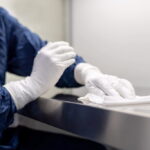Imagine walking into a laboratory where the next big discovery in biotech or life sciences is just a test tube away. The air buzzes with potential, every surface gleams with promise and every researcher’s eyes sparkle with determination. While it’s easy to get swept up in this whirlwind of innovation, one must not overlook the crucial component that keeps these fervent quests for knowledge from descending into chaos. The most important thing in many labs is adherence to safety measures. As many labs focus heavily on providing an environment for research that is not only productive but is also conscientious and secure with rigorous safety measures in place we can learn more about how important it is for research to be conducted in such an environment. In fact, to foster a culture of groundbreaking achievements, it’s critical to address the unsung hero of the research world: enhanced laboratory safety protocols.
Fostering a safety-first culture
At the heart of any world-class lab is a safety-first culture, where every member, from interns to lead scientists, operates with an ingrained sense of responsibility and awareness. Building such an environment starts with continuous education, ensuring every team member is up to speed on the latest safety practices, tailored to the specific risks and activities of their projects. Leadership plays a crucial role here, not just in enforcing rules, but in embodying the very ethos of safety, setting a standard for everyone to follow. This approach not only mitigates risk but also cultivates a workspace where everyone feels empowered to focus on their research, knowing their health and well-being are prioritized.
Implementing a safety-first approach also involves regular drills and emergency response exercises. By simulating potential incidents, laboratories can prepare their staff to handle real crises with confidence and efficiency. These activities help reinforce the importance of safety protocols and can unveil areas where the procedures may need fine-tuning or improvement. This proactive stance helps to engrain safety as an instinct rather than just a checklist, seamlessly integrating it into the daily rhythm of lab work.
Modern tools and technologies for safer labs
The rise of automation in laboratories presents a promising avenue for minimizing human error, a common source of accidents in the lab. From robotic arms handling volatile chemicals to automated ventilation systems ensuring optimal air quality, technology is revolutionizing how we approach safety. Additionally, wearable technology, like smart goggles that can detect hazardous conditions, or lab coats designed to monitor the wearer’s vitals, is playing an increasing role in personal safety. Paired with comprehensive lab management software, these tools provide a robust framework for not just reacting to but anticipating and preventing potential risks.
Effective communication pathways
A cornerstone of any effective safety strategy is clear, unambiguous communication. Establishing open channels for reporting safety concerns without fear of repercussion encourages a proactive approach to identifying and mitigating risks. Moreover, fostering a culture where near-misses are openly discussed rather than swept under the rug can turn these incidents into valuable learning opportunities. Clear, properly placed signage and labeling complement these efforts, ensuring that everyone is aware of potential hazards and how to protect themselves.
Ensuring environmental safety beyond the lab
The responsibility of a laboratory extends beyond its walls. Properly managing chemical waste, monitoring air quality and adopting sustainable practices are all essential components of a comprehensive safety protocol. These steps not only ensure the well-being of lab personnel but also safeguard the surrounding community and environment. By implementing green lab practices, such as minimizing the use of hazardous materials and enhancing energy efficiency, labs can diminish their environmental footprint while fostering a safer, more sustainable working environment.
As we advance into an era of unprecedented scientific discovery, the importance of robust safety protocols in laboratories cannot be overstated. By embracing a culture of safety, leveraging cutting-edge technologies, fostering clear communication and extending our concern to environmental impacts, we can ensure that our laboratories are not just incubators of innovation but also bastions of safety and well-being.
Did you find this helpful? Check out our other helpful articles on our website.
Read Also
- The Benefits of Contract Labor Staffing in HealthcareThe most successful healthcare facilities today aren’t just reacting to crises—they are building workforce resilience to withstand them. Unpredictable patient demand, coupled with persistent nursing shortages, has made the traditional staffing model obsolete. Relying on mandatory overtime to cover a sudden surge in capacity is a recipe for high turnover and rising employee burnout relief… Read more: The Benefits of Contract Labor Staffing in Healthcare
- Management Reinforcement for Healthcare Providers in a Shifting SystemHealthcare is changing faster than ever. So, providers are feeling the pressure to keep up. New technology, changing patient needs, and constant rule updates make it tough for managers to stay on top. Strong leadership helps teams work better, give great care, and stay happy in their jobs. Here’s how healthcare leaders can strengthen their… Read more: Management Reinforcement for Healthcare Providers in a Shifting System
- Why Effective Disinfection Remains the Foundation of Public HealthFrom hospitals and schools to transport hubs and food production sites, disinfection is central to breaking the chain of infection and protecting community health. The COVID-19 pandemic highlighted how crucial surface hygiene and environmental control are in reducing the spread of harmful microorganisms. Yet, beyond emergency response, routine and validated disinfection practices remain the cornerstone… Read more: Why Effective Disinfection Remains the Foundation of Public Health
- How to Navigate Your Medical Assistant Career PathBecoming a medical assistant can feel both exciting and a little stressful. This job lets you work closely with doctors and other healthcare workers to help patients. But with so many different paths to take, it can be hard to know where to start or how to plan your career. Wouldn’t it be nice to… Read more: How to Navigate Your Medical Assistant Career Path
- Benefits of Enrolling in Botox Training CoursesMany people want to enhance their skills in the beauty field, and one way to do that is through Botox training. With the rising popularity of Botox, enrolling in training courses can set you on a path to a rewarding career. If you are considering this option, you might be curious about the benefits that… Read more: Benefits of Enrolling in Botox Training Courses
- How Pilates Certification Enhances Professional Growth in HealthcareAre you looking for a way to expand your skills and stand out in healthcare? Pilates certification can be a powerful step in your professional journey. It not only helps you understand movement and body mechanics. It also gives you tools to support patient recovery. It also improves mobility, and promotes wellness. Ready to see… Read more: How Pilates Certification Enhances Professional Growth in Healthcare
- Understanding the Legality & Challenges in the Dental Aligner IndustryThe dental aligner industry has grown quickly in the past decade. More people are choosing clear aligners instead of traditional braces because they are less noticeable and often more convenient. While this growth has created new opportunities, it has also raised legal questions and practical challenges. Patients, dentists, and companies are still learning how to… Read more: Understanding the Legality & Challenges in the Dental Aligner Industry
- CPR Skills: Be Ready to Act When It Matters MostEvery year, many emergencies happen where lives are at risk and quick action is needed. One skill that can make a big difference is knowing CPR (cardiopulmonary resuscitation) and first aid. In these moments, knowing what to do can be the difference between life and death. By learning these skills, you protect yourself and become… Read more: CPR Skills: Be Ready to Act When It Matters Most









